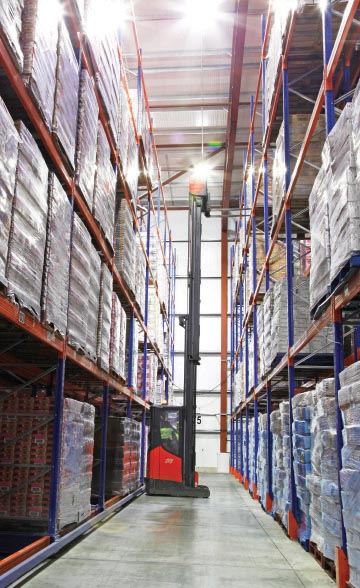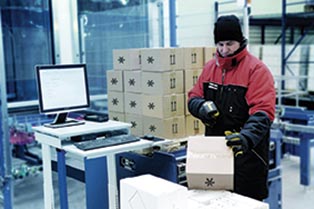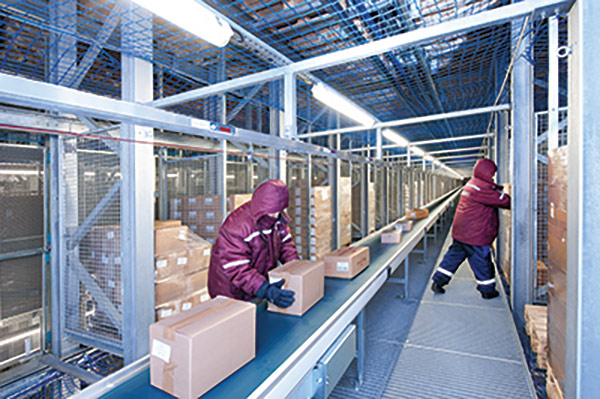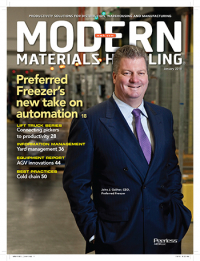Cold Chain Embraces Automated Storage
Whether semi- or fully-automated, cold storage facilities can automate to cut costs, improve labor productivity and achieve compliance.
The business case for automating temperature-controlled warehouses is stronger than ever. Not only are energy prices rising, but customer demands for faster, more accurate orders are increasing—all while the warehousing workforce is diminishing, with retired Baby Boomers not being replaced by enough Millennials.
Product damage, waste and energy savings can’t be overlooked, especially as companies strive to improve their environmental footprints. To ship orders out faster, optimize storage and labor productivity, decrease waste and exceed customers’ expectations, many cold storage distribution operations are reconsidering traditional warehouse and distribution system designs.
“Each client in cold chain logistics has unique requirements for increasing the performance of their operations. Nonetheless, the two primary areas of savings focus on labor and space,” says Adam Henkel, solutions development engineer for viastore. “To address these issues, along with others, traditional freezer and cooler warehouses are investing in automation.”
The cold chain is among the harshest environments in the industry, and mechanical and manual processes must be designed accordingly. As a result, warehouses are investing in two kinds of automated storage—automated storage and retrieval systems (AS/RS) systems and mobile racking—to keep workers warm and happy, reduce energy and increase productivity.
AS/RS for staging
To conserve two of their most important resources—time and money—Dan Labell, president of Westfalia Technologies, advises customers to manually pre-pick orders in cold storage environments. Labell says they should then consider AS/RS solutions to stage orders at proper temperatures, prior to delivering them right before trucks arrive to pick up. As a result, products remain in proper climate-controlled environments for as long as possible, so they won’t spoil. The trucks can then deliver products quicker and more efficiently, and avoid detention time charges—a driving factor behind order staging.
In addition to staging products at proper temperatures, operations must also ensure products are rotated properly and delivered accurately. After all, the costs of order inaccuracies are some of the most significant.
“When a customer needs a food product, that customer needs it the day of delivery. If an inaccurate order is delivered to a customer, a costly emergency expedited delivery is required to satisfy the customer,” says Tom Steininger, market development director for Dematic North America. “The cost to fix an incorrect order ranges from $100 to $500 on average. Traditional warehouses can experience several picking errors a day. However, automated systems may only experience a picking error once per month.”
Labell also believes operators should consider building order selection processes into their AS/RS so products remain in cold storage environments—without breaking the cold chain—until the exact moment they are delivered to trucks.
“This can be achieved by designing integrated pick tunnels so that personnel can access the inventory,” he explains. “The upper levels of the system generally store reserve product, and replenishments to the pick locations are thus automated. By automatically replenishing pick stations, AS/RS allows workers to travel minimal distances to pick orders, as warehouses become more compact and space efficient.”
AS/RS for picking
 AS/RS solutions can also help when fully automating picking inside a cold storage facility. For years, automated systems have been installed in cold temperature warehouses. However, most of the systems were unit load systems, which only automated full pallets inbound and outbound, as manual order selection was integrated sparingly.
AS/RS solutions can also help when fully automating picking inside a cold storage facility. For years, automated systems have been installed in cold temperature warehouses. However, most of the systems were unit load systems, which only automated full pallets inbound and outbound, as manual order selection was integrated sparingly.
The usage of unit load systems isn’t too surprising, especially when you consider how challenging automation can be within freezers—particularly when less-than-full-pallet orders are being filled—so the more simple the solution, the better. Since the materials used in more sophisticated automation don’t usually work well in sub-zero conditions, Labell advises operators to consider the following advice as they use AS/RS (and other order selection equipment) to maximize their automation potential in their cold storage environments.
- Lubrication and electrical wiring must be freezer rated. Oftentimes, component suppliers aren’t able to fully understand how their products perform in freezers. And electrical wiring, especially when it flexes often, will have shorter useful lives in colder temperatures than warmer temperatures. Operators should consider using freezer rated cables, as they can significantly improve reliability.
- Avoid corrosion. If electronic devices are removed from freezers and stored in warm environments for maintenance, operators must be careful to ensure they don’t corrode (due to condensation), or else their capacities for long-term usage will decline significantly.
- Maintenance-friendly systems are crucial. “A manufacturer of automation should have significant experience in cold temperature environments and offer mature solutions,” Labell says. “If they don’t, their risk profile increases dramatically.”
Saving energy
 By transitioning to full automation through AS/RS, companies will notice a considerable decrease in energy operating costs (upward of 35% to 50%), as automated warehouses offer more storage in less refrigerated space.
By transitioning to full automation through AS/RS, companies will notice a considerable decrease in energy operating costs (upward of 35% to 50%), as automated warehouses offer more storage in less refrigerated space.
“Energy costs for cooling are higher than heating and most loss is from the roof. AS/RS has a smaller roof surface, though,” Steininger says. “The doors to automated freezer warehouses are also smaller and are open less, which also provides additional operational efficiency through energy savings. And, of equal importance, automated warehouses only defrost once per week, compared to traditional warehouses, which defrost once per day, translating to even more energy savings.”
Some cold chain warehouses will also choose to outsource automation to 3PLs, who provide continuous improvement programs around energy savings, as utilities can comprise 10% to 20% of 3PLs’ operating costs. In doing so, 3PLs can monitor their usage of kilowatt hours and consistently decrease them on a monthly basis.
“Aside from AS/RS automation, 3PLs are also investing (and will continue to invest) in energy reduction methods like LED lighting, solar panels, dock doors and racking,” says Karen Erickson, consulting director for supply chain consultancy Armstrong & Associates.
Mobile racking
In cold storage facilities, owners often encounter a key dilemma. Should they focus primarily on storage density, which may result in double handling, labor inefficiencies and, ultimately, product damage? Or should they focus on product access instead? As they consider which objective is most important, they must also choose between designing storage space or using conventional storage/racking options.
With this in mind, some companies offer mobile racking, which, says Todd Jessup, principal at Flexspace, Storax’s exclusive North American partner, uses the proven storage method of using traditional, single select storage racks. In doing so, facilities have flexibility to accommodate low or high SKU counts, adjust vertical openings to accommodate product mix changes and have higher storage capacity percentages as honeycombing is eliminated.
“The only downside to using single select is the wasted space, which is what the mobile function of certain racking options addresses,” Jessup explains. “Simply put, the access aisle moves to the desired location when you want it and where you want it.”
Consequently, cold storage facilities are able to increase their pallet density by 60% to 100%. Furthermore, by amortizing an increase in pallets, cold storage operators can reduce their cost per pallet by at least 25%. At the same time, they can also decrease their upfront building sizes and capital purchases by developing smaller building footprints (typically 25% smaller than traditional warehouses, according to Dematic’s Steininger)—all while retaining the same number of pallets they would have used if they had used conventional storage methods and larger buildings.
“The benefits are also perpetual with operations,” Jessup adds. “Spreading energy costs, labor and other operating expenses over many more pallets reduces the cost to operate on a per-pallet basis.”
Additionally, due to the ease of mobile racking, operators and owners alike are able to focus on the basics as well—the typical benefits that single select racking offered in the past.
“For cold storage owners that really study the benefits, it’s an easy choice and case for ROI,” Jessup says. “The upfront cost is reduced, profit margins increase exponentially and operations professionals realize the ongoing benefits that are proven with single select racking.”
Companies mentioned in this article

Article Topics
Columns News & Resources
New resource center for weighing and dimensioning Protective packaging roundup MODEX C-Suite Q&A: Troy Donnelly, Senior VP of Sales, Marketing, and Application, DMW&H When Just-in-Time Just Doesn’t Work Recycling coastline plastic into premium reusable packaging Fresh food, anyone? RPCs protect in the supply chain Why Isn’t Your Loading Dock Connected to Your Supply Chain? More ColumnsLatest in Materials Handling
NetLogistik partners with Vuzix subsidiary Moviynt to offer mobility solutions for warehouses Materials Handling Robotics: The new world of heterogeneous robotic integration Lucas Watson appointed CSO for Körber’s Parcel Logistics business in North America Hyster recognizes Dealers of Distinction for 2023 Carolina Handling names Joe Perkins as COO C-suite Interview with Keith Moore, CEO, AutoScheduler.AI: MODEX was a meeting place for innovation Walmart deploying autonomous lift trucks at four of its high-tech DCs More Materials HandlingAbout the Author
Subscribe to Materials Handling Magazine

Find out what the world's most innovative companies are doing to improve productivity in their plants and distribution centers.
Start your FREE subscription today.
April 2024 Modern Materials Handling

Latest Resources












